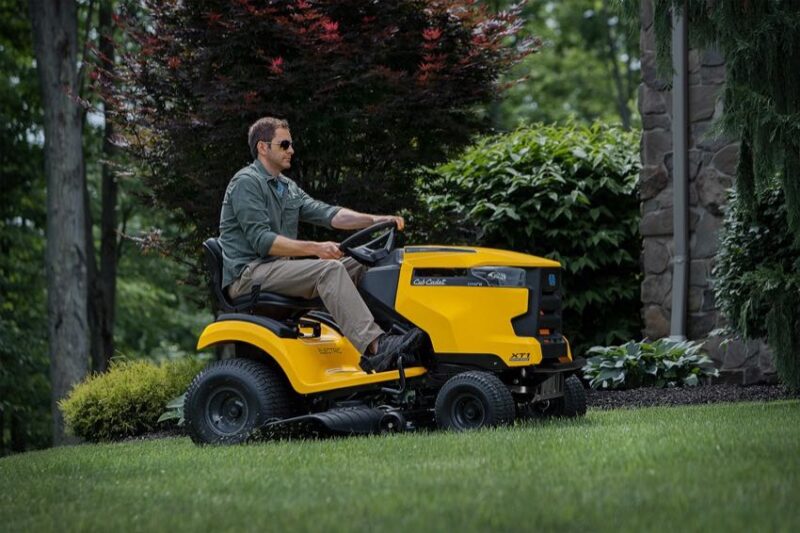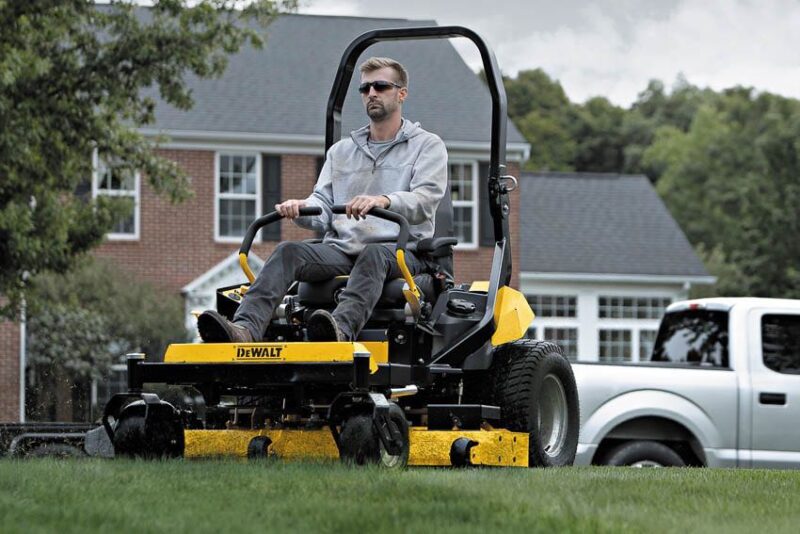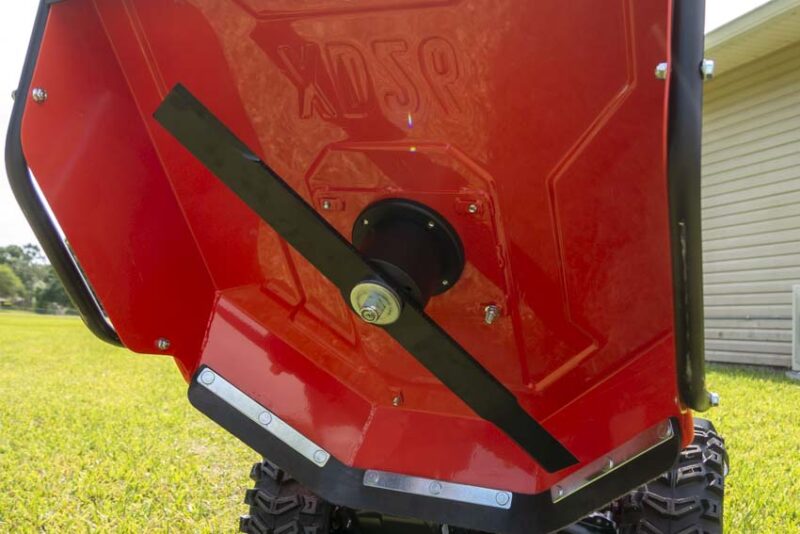A Guide to Lawn Mower Designs, Types, and Who They’re Best For
Lawn care is a necessary evil if you want to achieve an envy-worthy yard, but with the right mower, the experience can be much more enjoyable. We’re going over the different types of lawn mowers so you can balance the pros and cons to choose the right one for your yard.
Exploring Different Types of Lawn Mowers
With so many types of lawn mowers, determining the best one for you can be tricky. There are advantages and disadvantages to each type, even with the most popular brands. Adding to that, everyone has their own preferences, which can affect which type will serve you best.
For starters, most lawn mowers fall into one of two categories: walk-behind mowers or riding mowers. Within these categories, many different types of mowers exist. If you want to leave the dirty work to automation, there are also robotic lawn mowers that make taking care of your yard even easier.
Push Lawn Mowers

For most people, a push mower is what comes to mind when they picture a lawn mower. Push mowers are mowers that the user pushes and operates manually, as opposed to self-propelled and riding mowers (more on those later). They can run on electricity (corded), gasoline, battery, or manual power.
Push Mower Pros
If you have a lawn that’s under 1/4-acre, a push mower is a great place to start looking. These machines are easy to use and cost much less than riding mowers.
Push mowers also make it easy to move obstacles out of your way, as opposed to riding mowers that require you to brake and dismount.
Here are some advantages of the different drive types of push lawn mowers:
| Power Source | Advantages |
| Reel push mower (manual) | Easy to maintain and no power required |
| Gas-powered push mower | Inexpensive, light, and highly portable |
| Electric-powered push mower | Plug-and-play ease |
| Battery-powered push mower | Require no gas or cords, little to no maintenance, and many kits include multiple batteries |
Cons of Push Lawn Mowers
There are also several drawbacks to push mowers. They’re smaller than riding mowers, so they’re not the best option for large lawns. Also, many push mowers can struggle to mow through thick grass, causing added fatigue for the user.
Here are some disadvantages of the different drive types of push lawn mowers:
| Power Source | Disadvantages |
| Reel push mower (manual) | Doesn’t mow over sticks, difficult to operate on uneven ground, unreliable in thick or tall grass |
| Gas-powered push mower | Gas fumes can be bothersome and maintenance is required |
| Electric-powered push mower | You have to be careful not to run over the cord, and you’re limited to mowing only as far as your cord reaches |
| Battery-powered push mower | Limited battery life and replacement batteries can be costly |
Self-Propelled Lawn Mowers

Self-propelled mowers, like cars, can be front-wheel-drive (FWD), rear-wheel-drive (RWD), or all-wheel-drive (AWD). When you start them and put them in gear, these mowers propel themselves forward. This takes a lot of the load off of the user and makes for an easier mowing experience.
Self-Propelled Lawn Mower Pros
Self-propelled mowers can make mowing your lawn much easier compared to push mowers. They’re also more reliable on hills and slopes.
Here are the advantages of the three main types of self-propelled lawn mowers:
| Drive Type | Advantages |
| FWD self-propelled mower | Great for small, level lawns and easier to steer than other self-propelled mower types |
| RWD self-propelled mower | Handle slopes and rough terrain better than other mowers |
| AWD self-propelled mower | More speed and power compared to other walk-behind mowers |
Cons of Self-Propelled Lawn Mowers
While they give you a boost in performance, self-propelled mowers are more expensive than push mowers. They’re also heavier, making them harder to transport if needed. On the same token, they don’t steer as handily as other mowers, so they’re not the best choice for small lawns.
Here are the disadvantages of the three main types of self-propelled lawn mowers:
| Drive Type | Disadvantages |
| FWD self-propelled mower | Difficult to maneuver on slopes |
| RWD self-propelled mower | Hard to turn, and no reverse gear so you can’t mow backwards |
| AWD self-propelled mower | More difficult to maneuver than RWD mowers |
Riding Lawn Mowers

If your lawn is more than 1/4 acre, a riding mower is the best choice for you. There are several types of mowers that fall into this category, including:
- lawn tractors
- zero-turn mowers
- rear-engine mowers
- stand-on mowers
Pros of Riding Lawn Mowers
There are many reasons to choose a riding lawn mower. For starters, they’re much more comfortable and convenient and they’ll save time and energy compared to walk-behind mowers. You can also use them with different attachments to take your lawn care to the next level.
Here are some of the advantages of the three main types of riding lawn mowers:
| Type of Riding Mower | Advantages |
| Lawn tractor | Great for large lawns, less expensive than other riding mowers, and available in various transmission types |
| Zero-turn mower | Tons of maneuverability and steering power, available in wide deck sizes to speed up mowing on large properties |
| Rear engine mower | Ideal for mid-sized lawns, less expensive than other riding mowers |

Cons of Riding Lawn Mowers
If you’re looking for a mower within a small budget, riding mowers don’t usually fit the bill. On top of their initial cost, they require repairs and maintenance, which can be costly.
Here are the disadvantages of the three main types of riding lawn mowers:
| Type of Riding Mower | Disadvantages |
| Lawn tractor | More difficult to maneuver, especially around sharp corners |
| Zero-turn mower | More expensive than other types of riding mowers |
| Rear engine mower | Smaller cutting width than other riding mowers |
Robotic Lawn Mowers

Robotic mowers may seem like a thing of the future, but the first robotic mower was actually introduced in 1969, called the MowBot. It was a precursor to modern autonomous appliances like robotic vacuums.
Flash forward to today, and most robo-mowers operate using satellite location or boundary wire systems, making them accurate within 2-3 centimeters.
Pros of Robotic Lawn Mowers
Obviously, the main advantage of robotic lawn mowers is that they take care of the work without you needing to be present. They’re also quieter than gas mowers, cost less to operate, and leave your lawn looking neat and tidy.
Robo-mowers mow more frequently and leave the grass clippings for mulch, which can benefit your soil by adding nutrients back into your lawn. For seniors and people with disabilities, these mowers are a great option. They will even mow your lawn while you’re on vacation!
Cons of Robotic Lawn Mowers
Robotic mowers may sound like a dream come true, but that doesn’t mean they don’t come with their fair share of caveats.
These mowers have a high upfront cost, and you also need to keep your lawn free of obstacles like toys, pets, and furniture. Installation can be complicated, and they’re not ideal for lawns with hillsides or steep slopes.
These mowers work best on simple yards, and they’re not the best at trimming the edges of your yard, so some work may still be required on your part to keep your lawn manicured.
Cost Ranges of Different Types of Lawn Mowers

Most people have to stick to a budget when shopping for a lawn mower, but it’s important to note that less expensive can indicate subpar quality. The best lawn mower for you will be one that is the right balance between the pros and cons that fits into your budget.
Factors Influencing Cost
There are several factors that go into the cost of lawn mowers. Consider the following when you’re shopping for mowers:
Power sources
The least expensive models are corded electric, followed by gas-powered, and at the top-end, battery-powered mowers.
Cutting width

Mower deck width is also something to consider when making your decision since it determines how quickly you can mower your lawn. Most walk-behind mowers range from 14 inches to 22 inches in width, while riding mowers generally fall in the range of 30 inches to 61 inches.
Fuel and battery capacity
A larger fuel tank or an extra battery will make it easier to mow your lawn, but it goes without saying that it will cost more.
Speed
Most riding mowers can travel at speeds of around 4 to 9 miles per hour, and sometimes faster, in the case of zero-turn mowers. However, you should note that going too fast can compromise the cut quality and lead to choppy grass.
For commercial landscapers, there are several different types of ZT lawn mowers that provide the high speeds you need to mow large properties.
Price Comparison of Lawn Mower Types
Here are the average price ranges for various types of lawn mowers. Consider the advantages, disadvantages, and price of each type of mower to choose the best one for your yard and lifestyle.
Push Lawn Mowers Price Range
Push mowers are one of the most popular choices for homeowners, and they also happen to be the most affordable type of lawn mower.
| Type of Lawn Mower | Average Cost | Price Range |
| Reel push mower (manual) | $115 | $80 to $210 |
| Gas-powered push mower | $320 | $220 to $815 |
| Electric-powered push mower | $260 | $85 to $620 |
| Battery-powered push mower | $350 | $250 to $850 |
Self-Propelled Lawn Mowers Cost Range
The biggest factor that affects the cost of self-propelled mowers is their power source. SP mowers are powered by either gas, battery, or cord, but it takes a lot of energy to drive the wheels.
| Type of Lawn Mower | Average Cost | Price Range |
| Gas-powered SP mower | $630 | $270 to $3,310 |
| Corded electric SP mower | $675 | $180 to $1,570 |
| Battery-powered SP mower | $700 | $400 to $1,200 |
Riding Lawn Mowers Price Range
Since there are several subcategories of riding mowers, there are many factors that affect the cost. These include deck size, transmission type, and brand. Having this many options makes it easier for people on tight budgets to find a riding mower within their price range.
| Zero-turn Mower | Average Cost | Price Range |
| Lawn tractor | $3,500 | $2,000 to $5,500 |
| Zero turn mower | $5,000 | $3,000 to $7,500 |
| Rear-engine mower | $3,200 | $1,800 to $5,500 |
Robotic Lawn Mowers Cost Range
If you’re looking for a robotic mower for your lawn, consider the factors that influence the cost. For large yards, you need a mower with a long battery life, which will cost more money. However, if your budget allows, you can add extra features like edge-cutting, traction wheels for slopes, and extra charging stations for different zones in your yard.
| Type of Lawn Mower | Average Cost | Price Range |
| Robotic lawn mower | $1,320 | $630 to $5,670 |
Additional Costs to Consider
There are other conditions to consider when comparing the prices of lawn mowers, such as:
- Accessories and attachments
- Maintenance and repairs
- Replacement parts and blades
- Fuel and electricity costs
- Storage solutions and protective covers
Choosing the Best Lawn Mower for Your Lawn and Needs
With all of that being laid out, you can see that there’s a lot that goes into choosing the best lawn mower for your yard. To find the best one for your needs, note the size of your lawn, the terrain of your yard, and your budget amount, balancing the pros and cons for each model you’re considering.
Another factor to consider is your lawn care requirements. For example, if you’re growing a clover lawn, you’re probably safe to veer on the lower end of the budget since you won’t have to mow every week. However, if you have thick St. Augustine grass, it’s a good idea not to skimp on equipment since it will be used heavily.
Types of Lawn Mowers FAQs
Which type of lawn mower is best for small yards?
For small yards, a battery-powered walk-behind mower will let you mow quickly and save on fuel costs.
What type of lawn mower is ideal for large properties or uneven terrain?
Riding mowers work best for large properties, but not on uneven terrain. For rough terrain, front-engine riding mowers are a good choice. However, on sloped areas and hills, you should use a walk-behind mower or string trimmer.
How do I maintain and care for my lawn mower?

Your maintenance needs will vary based on what type of lawn mower you have, but all mowers benefit from regular blade sharpening. Sharp blades help to ensure your lawn stays lush and green, while also giving you an even cut.
How often should I replace my lawn mower blades?
For most homeowners, replacing your blades once a year is sufficient. We also recommend to sharpen your blades around twice per season, or after around 25 hours of use.
Are battery-powered lawn mowers worth the investment?
Battery-powered lawn mowers are one of the most popular types of lawn mowers across the board. They’re simple to operate and require little maintenance, making them a worthwhile investment for most homeowners who want to go gas-free.



